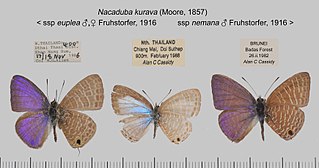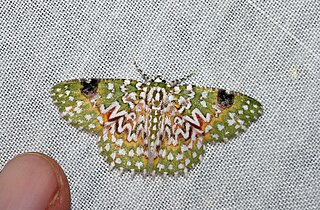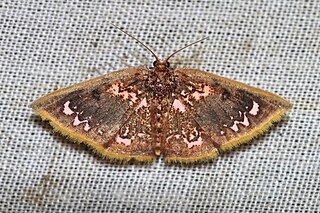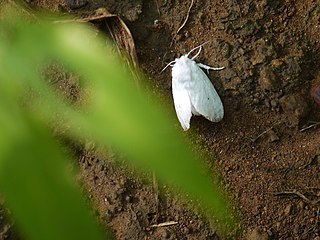
Parantica aglea, commonly known as the glassy tiger, is a butterfly found in the Indomalayan realm. The species is a member of the Danainae subfamily of the Nymphalidae family.

Ixias marianne, the white orange tip, is a small butterfly of the family Pieridae, found in India and Sri Lanka.

Ixias pyrene, the yellow orange tip, is a small butterfly of the family Pieridae, that is, the yellows and whites, which is found in Sri Lanka, India and southeast Asia.

Euploea klugii, the brown king crow or king crow, is a butterfly from the family Nymphalidae found in India and Southeast Asia. The species was first described by the entomologist Frederic Moore in 1858.

Azanus jesous, the African babul blue or topaz-spotted blue, is a small butterfly found in Africa, Egypt, Syria, India, Sri Lanka and Myanmar that belongs to the lycaenids or blues family.

Nacaduba kurava, the transparent six-line blue, is a species of butterfly in the family Lycaenidae found in Asia and Australia. The species was first described by Frederic Moore in 1857.

Yepcalphis is a monotypic moth genus of the family Noctuidae erected by Nye in 1975. Its only species, Yepcalphis dilectissima, was first described by Francis Walker in 1858. It is found in Sri Lanka, the Oriental tropics, the Philippines, Sulawesi and the Sula Islands.

Egnasia is a genus of moths of the family Erebidae. The genus was first described by Francis Walker in 1859.
Nolasena is a monotypic moth genus of the family Erebidae. Its only species, Nolasena ferrifervens, is found in India, Sri Lanka, Borneo and the Philippines. Both the genus and species were first described by Francis Walker in 1858.

Callopistria rivularis is a species of moth of the family Noctuidae. It is found from the Indo-Australian tropics of India, Sri Lanka up to the Solomon Islands and Fiji.

Eucyclodes gavissima, the Oriental orange banded green geometer moth, is a species of moth of the family Geometridae described by Francis Walker in 1861. It is found in the Indian subregion, Sri Lanka, Bhutan, western China, Taiwan, Vietnam, Sumatra and Borneo.

Callidrepana patrana is a moth in the family Drepanidae. It was described by Frederic Moore in 1866. It is found in Nepal, India, Cambodia, Sri Lanka, Thailand, mainland China, Japan and Taiwan.
Lemyra subfascia is a moth of the family Erebidae. It was described by Francis Walker in 1855. It is found in Sri Lanka.

Chrysocraspeda abhadraca is a species of moth in the family Geometridae described by Francis Walker in 1861. It is found in Indian subregion including India and Sri Lanka, Peninsular Malaysia, Sumatra and Borneo.
Brana is a monotypic moth genus of the family Noctuidae. Its only species, Brana calopasa, is found in Sri Lanka and Australia. Both the genus and species were described by Francis Walker, the genus in 1858 and the species in 1859. It It is a serious pest on Berrya cordifolia.
Egnasia accingalis is a moth of the family Noctuidae first described by Francis Walker in 1858. It is found in India and Sri Lanka.
Egnasia participalis is a moth of the family Noctuidae first described by Francis Walker in 1891. It is found in India and Sri Lanka. It has a 28 mm wingspan, a yellow-colored body and a forewing with the lunulate hyaline (glass-like) mark at the end of the cell. The outer lines of both wings are slightly sinuous. In the hindwing, the outer line rises from near the apex.
Episparis liturata is a moth of the family Noctuidae first described by George Hampson in 1893. It is found in India, Sri Lanka, Java, Borneo, Myanmar, China and Thailand.
Trisula variegata is a moth of the family Noctuidae first described by Frederic Moore in 1858. It is found in India, Sri Lanka, Nepal, Thailand, South China, Indonesia and the Philippines.

Altha subnotata is a moth of the family Limacodidae first described by Francis Walker in 1865. It is found in Sri Lanka, India and Nepal.














